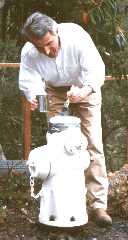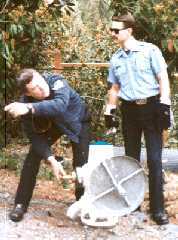Every water supply program should have some form of mission statement that can guide the
overall direction and accomplishments of the program. Here, presented as an example, is
the mission statement for the water supply program for the Moraga-Orinda Fire District which
is a suburban district that covers two incorporated cities, rural areas and a college campus.
Mission Statement
To provide readily accessible, reliable and sufficient water supply for
all probable fires within the developed areas of the Moraga-Orinda
Fire Protection District.
With the mission statement made, one then needs to understand how the statement
concepts are developed into a working program. Following the MOFD program, here
is what we have done.
Program Context

|
The fire district actually owns only a small number of fire hydrants. About
1300 hydrants belong to the local water service, the East Bay Municipal Utility District
(EBMUD.) About 80 hydrants are owned by non-municipal interests such as
CalTrans, BART, St. Mary's College, the local school districts, East Bay Regional Parks,
the Watershed Division of EBMUD and private property owners who have installed their own systems.
|

|
The fire district's program is primarily one of inspection and service and, in most cases,
coordinating repairs and necessary water system maintenance with the legally responsible
parties.
General Program Objectives

- Maintain all fire hydrants in accessible, working order.
- Maintain markings and other indicators so that companies
can rapidly determine the capacity and characteristics of
each hydrant.
- Work with EBMUD to improve areas with less than desirable
fire flows.
- Work with property owners to develop sources of water
outside the municipal water distribution system.
- Systematically replace all obsolete (preexisting non-conforming)
hydrants on the water system.
Specific Program Objectives

- Inspect and service each hydrant at least once per year. Flow test all
hydrants on an average of once every three years.
- Maintain color coding and other markings consistent with the most
current hydrant testing data.
- Identify weak distribution zones. Provide data for the Fire Flow Reconnaisance Study
and similar programs which are designed to detect, identify and mitigate
weaknesses in the municipal water system.
- Establish joint participation projects in watershed areas and on private properties
to develop permanent fire department acess to rural water supplies.

- Develop low cost projects to replace approximately 300 hydrants which do not have
"steamer" outlets within a ten year period.
- Mitigate excessive spacing between fire hydrants in older areas through cost sharing
projects and agreements.
